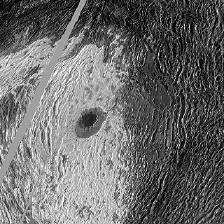Article from: August 1995 Sky & Telescope,
p. 13
Metal "Frost" on Venus?
Ever since the 1970's when radar became the instrument of choice
for studying Venus, geochemists have puzzled over a strange characteristic exhibited
by the planet's mountains and high plateaus. Beginning about 3.5 kilometers (km)
above
mean "sea level" the landscape abruptly becomes a strong reflector of
radio energy creating the impression of a radar-bright "snow" at higher
elevations that cannot be explained by surface textures.
 |
Photo: Maxwell Montes, the highest
mountain complex on Venus, rises almost 11 kilometers above the surrounding plain.
Maxwell's upper slopes appear anomalously reflective (bright) when probed by radar,
in ways that cannot be explained merely by surface roughness. A trio of geochemists
have recently suggested that a thick "frost" of metal-bearing compounds
is responsible for the radar-bright nature of Maxwell and other high-standing plateaus
on Venus. Cleopatra, the dark, double-ring impact basin right of center, is 100
km across and considered relatively young. |
The planet is much too hot for real snow to exist so a variety
of minerals with high dielectric constants have been suggested to explain the phenomenon.
Pyrite (fool's gold) has the right crystal properties but is unstable in the planet's
torrid, high-pressure environment. Other candidates have also proven implausible
– at least in the amounts needed to create a layer with the observed radar-reflective
properties.
Now Robert A. Brackett, Bruce Fegley Jr., and Raymond E. Arvidson
(Washington University) have suggested a likely solution. Writing in the January 25th
Journal of Geophysical Research, they note that metal "salts" involving
chlorine, fluorine, and sulfur, as well as certain other metal-bearing minerals,
have dielectric constants high enough to explain the radar observations. Such compounds
are rather common in volcanic eruptions on Earth and should occur in those on Venus
too.
The planet has a mean surface temperature of 740 degrees
Kelvin,
but that value falls by 8.5 degrees for every kilometer of altitude. Many of the
team's candidate compounds are quite volatile at such hellish temperatures and should
gradually migrate as vapor to higher elevations, where they presumably
re-condense
as a kind of frost onto the somewhat cooler ground. The most volatile of these species
could creep several kilometers up slope in just a few hundred years and given enough
time, create accumulations millimeters to centimeters thick.
"This model seems to explain the radar properties in
a geochemically plausible way" Brackett notes. In fact, it provides a good reason
why the very highest elevations on Venus appear radar dark (for example. the streaks
seen above near the center of Maxwell Montes). Brackett thinks the minerals capping
the summits are very volatile, thus accelerating their migration to the highest ground,
and are radar dark in solid form.
Metal-based vapors or ions coursing through the planet's lower
atmosphere might also explain an unexpected "anomaly" that occurred
during the Pioneer Venus mission in 1978. As the mission's four probes plunged through
the atmosphere, all instruments with external sensors mysteriously failed 12.5 km
above the surface. Some analysts have suggested that this multiple anomaly could
have resulted from ions accumulating, or metallic compounds condensing on the probes'
outer surfaces – both easily possible if the right volcanic gases were present.

Please send questions or suggestions to:
SEGway
(outreach@ssl.berkeley.edu)
Lawrence Hall of Science Home
Copyright © 1997 Regents of the University of
California
Updated
August 02, 2000


